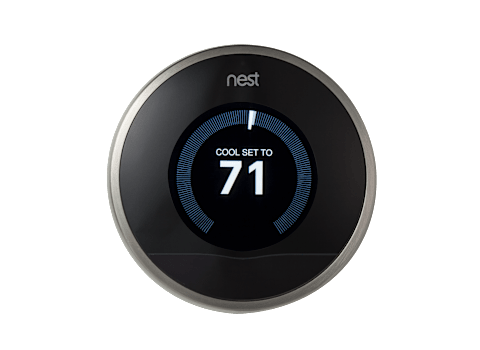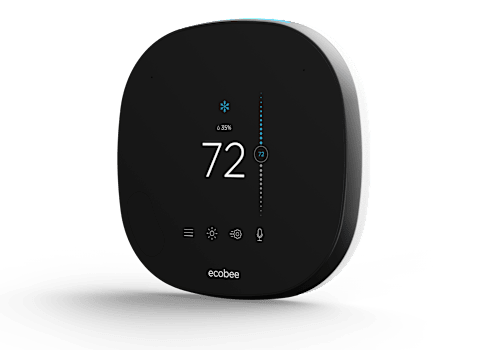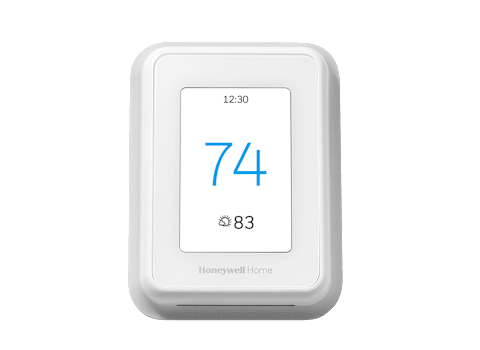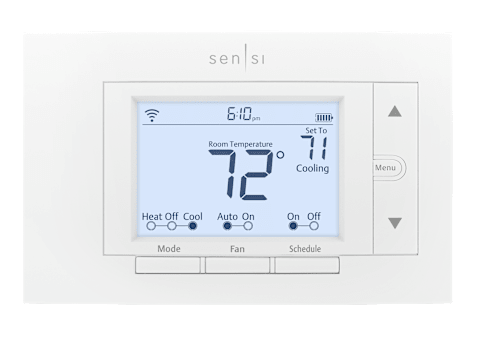They can often pay for themselves through savings on your cooling and heating cooling bills, but there are exceptions

By Liam McCabe
Smart thermostats have been widely available for more than a decade now, and the consensus is clear: Yes, smart thermostats can be a worthwhile upgrade for many heating and cooling systems, trimming your utility bills while keeping your home comfortable.
If a thermostat can connect to WiFi (or Z-Wave, a smart-home-specific wireless standard), we consider it “smart.” Consumer Reports has tested dozens of smart thermostats in our lab, and currently, our ratings have 50 models. They range from basic models that simply let you adjust the temperature from an app through high-end models from the popular Google Nest and Ecobee lines that try to learn your habits and routines to save you money on energy while keeping your home at a desirable temperature. CR members can see our full ratings based on their automation features, manual controls, and more. (We also have ratings for programmable thermostats.)
Here, we’ll dive into how smart thermostats help optimize your home’s heating, ventilation, and air conditioning (HVAC) system—or not, because some households don’t gain much by switching to one.
How Smart Thermostats Might Save You Money
There is good evidence that smart thermostats can help most users save money. According to real-world data gathered by the Environmental Protection Agency, smart thermostats that meet Energy Star criteria save users an average of 8 percent on their utility bills. Another study, in which smart thermostats were installed in low-income, multifamily housing, found a similar savings rate. That’s about $50 per year, though the savings might be greater in places with frigid winters, brutal summers, or high energy prices. On the flip side, you might save less if you live in a temperate climate, or if your energy bill is already low.
The secret to the energy savings is pretty simple: Smart thermostats turn off the heat and AC more often than regular thermostats, without sacrificing comfort.
One way that smart thermostats can do this is by figuring out when nobody is home, most commonly with motion sensors, or by checking the location of your phone (also known as geo-fencing). When the thermostat senses that your house is empty, it’ll switch to an energy-saving mode that turns back the temperature (up in the summer, down in the winter). It’s the same effect as adjusting your thermostat by hand when you leave the house—but these smart thermostats do it automatically, so you don’t have to remember to adjust it yourself.
Half of the smart thermostats in CR’s current ratings have a motion sensor, or geo-fencing, or both. These features play a big role in a product’s overall rating, according to CR’s head of home-improvement testing, John Galeotafiore. “It’s hard to get a high rating without those,” he says.
The other major energy-saving technique is that smart thermostats make it easy to set up a sensible heating and cooling schedule. This often means programming the thermostat to turn back the system when you’re asleep, or when the house tends to be empty during the day, like during school and work hours. This overlaps with what motion sensors and geo-fencing can do, but not all smart thermostats have those features, and not every user wants them.
Ultimately, if you can bear to set your thermostat back 7° to 10° F for 8 hours a day, the Department of Energy estimates that you can save as much as about 10 percent on your heating and cooling bills with most types of heating and cooling systems.
Regular programmable thermostats (without WiFi or smartphone apps) have been able to do this for decades. But their button- (or touch-screen-based) scheduling interfaces tend to be cumbersome, and research estimates that about 40 to 70 percent of programmable thermostat users don’t take advantage of these features. The app-based interfaces for smart thermostats are much easier to use, which likely contributes to the real-world energy savings that they achieve.
At the high end of the category, so-called “learning” thermostats try to automatically set a heating and cooling schedule based on when you tend to be home, and how you’ve used the thermostat over time. This feature is also heavily weighted in our product ratings, according to CR’s Galeotafiore.
Smart thermostats often integrate a few other strategies and features, including reports on how often your system runs, or some nudgy messages about saving energy by choosing milder temperatures. Many models also remind you to replace your HVAC filter, too (usually every three months). Finally, some models can connect to programs that allow your utility company to adjust the thermostat settings in exchange for discounts or incentives.
At the very least, if you don’t use motion sensors, geo-fencing, learning algorithms, or even basic scheduling, you’ll still be able to turn your thermostat off from an app on your phone, which can be a big energy-saver if you forget to do it manually before you leave on a long trip.

Many smart thermostats keep records of how many hours they run, and you can access the reports through their companion apps.
Photo: Oscar Wong/Getty Images, Screen: Consumer Reports
Keeping Comfortable With a Smart Thermostat
While many energy-conserving tips and techniques require some level of discomfort or sacrifice, smart thermostats can save energy while maintaining or even improving the comfort in your home.
For example, in a June 2021 nationally representative survey (PDF) of 2,280 U.S. adults, Consumer Reports found that people who own smart thermostats kept their AC set to the same temperature on average—72° F—as people who had regular programmable thermostats or manual thermostats. Essentially, those who use smart thermostats get to enjoy the same comforts from their AC while they’re home while still saving more energy on average while they’re away, thanks to automation and ease of use.
Some smart thermostats also work with remote temperature sensors that can help you get the right temperatures in the right rooms at the right time. If your main thermostat is on the first floor but you spend most of your day working in a second-floor home office that runs warm, you can pop a remote sensor on your desk so that the AC kicks in as needed—and before you sweat through your shirt. These sensors can’t fix all the problems of an unbalanced HVAC system, and could actually increase your energy bills by running the system more often, but it’s an option to consider.
And the simple ability to turn on your HVAC system from your smartphone can be a boon for comfort, too. If you’re coming back from a long trip and the thermostat has been turned way down, you can set it to your normal temperature from the tarmac or the interstate an hour or two before you get home, so it’ll feel comfortable when you arrive.
When a Smart Thermostat Isn't Worth It
Some people might find that a simpler thermostat suits their needs better than a higher-end model with automation. People who understand and appreciate how smart thermostats work—essentially letting their house get warmer or colder sometimes—tend to be satisfied with them, according to Bryan Orr, founder and owner of HVACRSchool.com and president of Kalos Services in Clermont, Fla. “But if the client doesn’t understand it, then they don’t tend to value it,” he adds. He says that even some of his nerdier clients still sometimes find themselves puzzled by the behaviors of learning algorithms on higher-end smart thermostats.
If you’re worried that a fancy-pants smart thermostat might get on your nerves, you can use one of the many relatively simple smart thermostats that connect to WiFi for remote control but don’t bother with learning algorithms or occupancy sensors.
In some homes, a smart thermostat simply won’t do much to save energy or improve your comfort, especially if you’ve already picked off all the low-hanging fruit of energy conservation.
For example, if you already have a “regular” programmable thermostat that you’ve set up with scheduled heating and cooling periods, a smart thermostat may not save much additional energy.
Homes that are occupied most of the time on most days will see smaller savings because there won’t be as many opportunities for the empty-house energy-conserving modes to kick in.
In temperate climates, where energy use and utility bills are naturally lower, a smart thermostat will save less money than average, and certainly less than in places with very hot summers and frigid winters, particularly if they also have high energy costs. It should still trim your costs by about 8 percent on average, but that’s 8 percent of a relatively low number in the first place.
Modern variable-speed air conditioners and especially heat pumps are designed to work better and more efficiently when they run constantly at a fixed temperature. So a smart thermostat’s big energy-saving tool—turning off the system periodically—can actually work against that goal. (A simple smart thermostat that doesn’t automatically change your settings could still make sense, though.)
Finally, if you have an older HVAC system without a C-wire (basically a dedicated power line for your HVAC), you’ll need to select a smart thermostat carefully. Many models won’t work without one. C-wire adapters are sometimes available, but they don’t always work well. And even if a smart thermostat can work without a dedicated C-wire, it won’t always work with very basic two-wire, heat-only systems. In our ratings, we indicate which smart thermostats will work with these legacy setups.
Electric baseboard radiators generally won’t work with most smart thermostats, either, because the voltage levels are mismatched. There are exceptions, though CR hasn’t tested them.
Google Nest Learning Thermostat

CR’s take: The Google Nest Learning Thermostat earns one of the top spots in our smart thermostat ratings. It also stands apart with its physical design and software interface, featuring a slick combination of the old and new. By its appearance and manual operation, it harks back to a time when temperature was adjusted by turning the thermostat dial. Under the covers, though, it’s apparent that the designers have discarded old paradigms for a fresh approach to controlling indoor temperature. The Nest earns an Excellent rating for automating heating and cooling, and offers a wealth of smart features to enhance its functionality, including an occupancy sensor, geofencing, and voice and app control via Amazon Alexa, Google Assistant, and Samsung SmartThings. One caveat: Our testers find that the manual controls aren’t the easiest to use. Google also makes wireless remote Nest Temperature Sensors for the thermostat, which are sold separately for about $39 each at Google and Home Depot.
ecobee Smart with Voice Control EB-STATe5-01

CR’s take: The Ecobee Smart With Voice Control EB-STATe5-01 blends a simple interface with plenty of bells and whistles for precise programming. The thermostat learns your heating and cooling habits and adjusts its programming accordingly. It also comes with a wireless remote temperature sensor to place in an area or room that runs hotter or cooler than the area around the thermostat. The thermostat can then either average the temperatures at the sensor and the thermostat itself to heat or cool your home to a uniform temperature, or prioritize the sensor’s temperature over the thermostat’s temperature by using the sensor’s built-in occupancy detection. The thermostat itself also features a built-in occupancy sensor to tell whether people are in the room. Other features include vacation scheduling, a touch screen, built-in Amazon Alexa for voice control, and compatibility with Apple HomeKit, Google Assistant, Samsung SmartThings, and others for app and/or voice control. Ecobee sells additional remote temperature sensors in a two-pack for around $100 at Best Buy and Ecobee.
Honeywell Home T9 RCHT9510WF

CR’s take: The sleek Honeywell Home T9 RCHT9510WF garners an Excellent rating in our test for manual operation and does a great job of automating your heating and cooling. This thermostat comes with a wireless remote temperature sensor for more precise heating and cooling throughout your home and offers a number of other features, including geofencing, a built-in occupancy sensor, a touch screen, vacation scheduling, and voice and app control via Amazon Alexa, Google Assistant, and Samsung SmartThings. Additional temperature sensors cost around $40 each, and are available at Amazon, Best Buy, and Honeywell Home.
For a version of this thermostat that can also control whole-home humidifiers, dehumidifiers, and ventilators, consider the similar Honeywell Home T10 Pro THX321WFS. We haven’t tested it, but we expect it to offer identical performance.
Emerson Sensi WiFi ST55

CR’s take: The simple Emerson Sensi might be all you want in a smart thermostat. It connects to WiFi so that you can easily set a schedule through its app or adjust the temperature remotely. It just does without all the location sensors and learning algorithms that our higher-rated models include (hence its comparatively low Overall Score). The Sensi can work with some dead-simple HVAC setups, too, including two-wire, heat-only systems, or others without a C-wire. (It can even run on AA batteries, like old programmable thermostats.)
Consumer Reports is an independent, nonprofit organization that works side by side with consumers to create a fairer, safer, and healthier world. CR does not endorse products or services, and does not accept advertising. Copyright © 2023, Consumer Reports, Inc.